"From Dictatorship to Democracy" was written at the request of Tin Maung Win (now deceased), a prominent exile Burmese democrat who was then editor of "Khit Pyaing" (The New Era Journal).
It was originally published in installments in "Khit Pyaing" in Burmese and English in Bangkok, Thailand in 1993 and afterwards as a booklet in both languages (1994) and in Burmese again (1996 and 1997). The original booklet editions from Bangkok were issued with the assistance of the Committee for the Restoration of Democracy in Burma.
It was circulated both surreptitiously inside Burma and among exiles and sympathizers elsewhere.
The preparation of this text was based on over forty years of research and writing on nonviolent struggle, dictatorships, totalitarian systems, resistance movements, political theory, and other topics. Also, I had the assistance of Bruce Jenkins in the preparation of this analysis. This still took four months full time. It was intended only for use by Burmese democrats and various ethnic groups in Burma that wanted independence from the Burman-dominated central government in Rangoon. (Burmans are the dominant ethnic group in Burma.)
I could not write an analysis that had a focus only on Burma, as I did not know Burma well. Therefore, I had to write it as a generic analysis. This decision to make the analysis generic was at the time solely based on my limited knowledge of Burma.
I did not then envisage that the generic focus would make the analysis potentially relevant in any country with an authoritarian or dictatorial government. However, that appears to have been the perception by people in who in recent years have sought to translate and distribute it in their languages for their countries.
The Albert Einstein Institution (then in Cambridge, and later in Boston, Massachusetts, USA) solicited funds from the Open Society Institute that made possible the translation and publication of "From Dictatorship to Democracy" into four of the ethnic languages of Burma: Mon, Karen, Jing Paw, and Chin. The English text and the translations into Burmese and the four ethnic languages of Burma have recently been made available on the Albert Einstein Institution web site (aeinstein.org).
Free download from http://www.aeinstein.org/organizations98ce.html

| Attachment | Size |
|---|---|
| FDTD.pdf | 404.87 KB |
The Opinion Makers: An Insider Exposes the Truth Behind the Polls
Posted May 22nd, 2010 by jpritikin
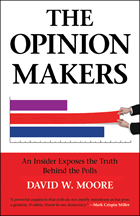
A former senior editor at the Gallup Poll shows how pollsters don’t report public opinion, they manufacture it
Since the mid-1930s, Americans’ opinions on everything from presidents to products have been a central part of news reporting. Today, the news media dominates the polling industry. David W. Moore—lauded as a “scholarly crusader” by Herbert Mitgang in the New York Times—exposes an industry intent on serving headlines rather than democracy and the sometimes disastrous consequences for all Americans, from the myth of public support for the invasion of Iraq to early presidential frontrunners selected not by voters but by pollsters.
In this presidential election year, Moore offers a fresh approach to the candidates’ polling percentages including that pre-election polls conceal rampant voter indecision. He profiles pollsters’ tactics and demonstrates why public policy polls are almost always wrong. Going beyond a clear and critical argument for reform, Moore outlines steps to make polls deliver on their promise to monitor the pulse of democracy.
Moore, David. (2008). The opinion makers: An insider exposes the truth behind the polls. Beacon Press.
Direct Democracy and the Courts
Posted October 29th, 2009 by jpritikin

Who should have the last word on fundamental policy issues? This book analyzes the rise of two contenders – the people, through direct democracy, and the courts. Introduced in the U.S. during the Progressive Era and now available in nearly half the states, direct democracy has surged in recent decades. Through ballot measures, voters have slashed taxes, mandated government spending, imposed term limits on elected officials, enacted campaign finance reform, barred affirmative action, banned same-sex marriage, and adopted many other controversial laws. In several states, citizens now bypass legislatures to make the most important policy decisions. However, the “people’s rule” is not absolute. This book demonstrates that courts have used an expanding power of judicial review to invalidate citizen-enacted laws at remarkably high rates. The resulting conflict between the people and the courts threatens to produce a popular backlash against judges and raises profound questions about the proper scope of popular sovereignty and judicial power in a constitutional system.
Miller, K. (2009). Direct Democracy and the Courts. Cambridge University Press.
When the People Speak: Deliberative Democracy and Public Consultation
Posted October 22nd, 2009 by jpritikin
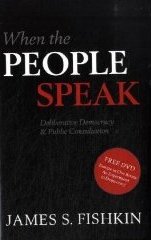
All over the world, democratic reforms have brought power to the people, but under conditions where the people have little opportunity to think about the power that they exercise. In this book, James Fishkin combines a new theory of democracy with actual practice and shows how an idea that harks back to ancient Athens can be used to revive our modern democracies. The book outlines deliberative democracy projects conducted by the author with various collaborators in the United States, China, Britain, Denmark, Australia, Italy, Bulgaria, Northern Ireland, and in the entire European Union. These projects have resulted in the massive expansion of wind power in Texas, the building of sewage treatment plants in China, and greater mutual understanding between Catholics and Protestants in Northern Ireland. The book is accompanied by a DVD of "Europe in One Room" by Emmy Award-winning documentary makers Paladin Invision. The film recounts one of the most challenging deliberative democracy efforts with a scientific sample from 27 countries speaking 21 languages.
Fishkin, J. (2009). When the People Speak. Oxford University Press.
Creating a Democratic Public
Posted January 22nd, 2009 by jpritikin
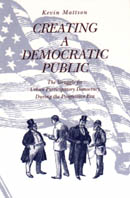
[original] "Ultimately Mattson challenges readers to reconsider contemporary conceptions of democracy that view citizens as consumers, and he contributes to contemporary discussions of ways to invigorate democratic practice. Highly recommended for all readership levels."-Choice
"In an era of quickening concern about citizenship and community in contemporary America, we have a lot to learn from the community-building activities of Progressive Era reformers. Kevin Mattson’s instructive account of their successes and failures is a timely contribution."-Robert D. Putnam, Harvard University
"The Progressive Era was filled with the rhetoric of democracy, but in recent years historians have found the meaning of progressivism rather in various hierarchies of power. Kevin Mattson’s considerable accomplishment in this fine book is to recover the era’s emergent democratic public and its localized activities, from adult education to political meetings. Mattson’s openly committed history is important for its more complicated rendering of progressive democracy, for its elaboration of a lively public culture, and for the encouragement it offers to the project of participatory democracy." -Thomas Bender, New York University
"Kevin Mattson’s book recovers one of the most important moments in the history of genuinely democratic reform in American history. A major contribution to the rethinking of progressivism, this book also offers a usable past to those struggling in the present to render our politics and culture more democratic."-Robert Westbrook, University of Rochester
During America’s Progressive Era at the beginning of the twentieth century, democracy was more alive than it is today. Social activists and intellectuals of that era formed institutions where citizens educated themselves about pressing issues and public matters. While these efforts at democratic participation have largely been forgotten, their rediscovery may represent our best hope for resolving the current crisis of democracy in the United States.
Mattson explores the work of early activists like Charles Zueblin, who tried to advance adult education at the University of Chicago, and Frederic Howe, whose People’s Institute sparked the nationwide forum movement. He then turns to the social centers movement, which began in Rochester, New York, in 1907 with the opening of public schools to adults in the evening as centers for debate over current issues. Mattson tells how this simple program grew into a national phenomenon and cites its achievements and political ideals, and he analyzes the political thought of activists within the movement—notably Mary Parker Follett and Edward Ward—to show that these intellectuals had a profound understanding of what was needed to create vigorous democratic practices.
Creating a Democratic Public challenges us to reconsider how we think about democracy by bringing us into critical dialogue with the past and exploring the work of yesterday’s activists. Combining historical analysis, political theory, and social criticism, Mattson analyzes experiments in grassroots democracy from the Progressive Era and explores how we might foster more public involvement in political deliberation today.
Mattson, K. (1998). Creating a Democratic Public. Pennsylvania State University.
Citizen Power: A Mandate for Change
Posted August 29th, 2008 by admin
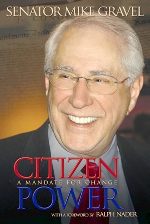
As author of Citizen Power in 1971, Senator Mike Gravel determined that much of what he wrote then is apropos in America today; hence, the release of Citizen Power: A Mandate for Change that reflects the accuracy of his evaluation of problems then, his current position on a number of issues facing America now, and the process that Americans can undertake to become empowered as lawmakers in partnership with their elected officials. Most chapters of Citizen Power: A Mandate for Change present material from the original book, as well as new information and revised positions. ISBN: 978-1434343154
The Right to Vote: The Contested History of Democracy in the United States
Posted August 13th, 2008 by jpritikin
At its birth, the United States was not a democratic nation—far from it. The very word democracy had pejorative overtones, summoning up images of disorder, government by the unfit, even mob rule. In practice, moreover, relatively few of the new nation’s inhabitants were able to participate in elections: among the exclude were most African Americans, Native Americans, women, men who had not attained their majority, and adult white males who did not own land. Only a small fraction of the population cast ballots in the elections that elevated George Washington and John Adams to the august office of the presidency.
Keyssar, A. (2001). The right to vote: The contested history of democracy in the United States. Basic Books.
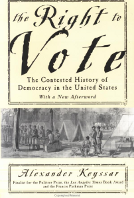
| Attachment | Size |
|---|---|
| keyssar_2002.pdf | 51.74 KB |
Democracy by Initiative: Shaping California's Fourth Branch of Government, 2nd Edition
Posted August 9th, 2008 by jpritikin
Ballot initiatives have reshaped the lives of California citizens for almost 100 years, yet the initiative process itself has become outmoded, inflexible, confusing, complex, difficult for citizens to use and excessively dominated by money, concludes a new report.
Center for Governmental Studies. (2008). Democracy by Initiative: Shaping California’s Fourth Branch of Government, 2nd Edition. Center for Governmental Studies.
This book is available online.
| Attachment | Size |
|---|---|
| cgs_dbi_full_book_f.pdf | 1.97 MB |
Ordinary People Doing the Extraordinary: The Story of Ed and Joyce Koupal and the Initiative Process
Posted August 9th, 2008 by jpritikin
Ober, D., & Hunn, D. (2001). Ordinary people doing the extraordinary: The story of Ed and Joyce Koupal and the initiative process. People’s Lobby.
A preliminary version is available for download.
| Attachment | Size |
|---|---|
| koupals.pdf | 359.58 KB |
Direct democracy: Facts, arguments and experiences on the introduction of initiative and referendum
Posted June 7th, 2008 by jpritikin
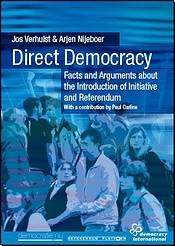
[Free download] How democratic are our political systems? Around a century ago, many countries in Europe introduced universal voting rights. Since then, the opportunities for citizens to take part in the political decision-making process have for the most part never been extended any further. But society has definitely evolved considerably. This up-to-date book pleads for a major democratic step forward.
Representative political systems are at odds with the principle of popular sovereignty. A small group of party leaders makes the major decisions. Public debate about our future only flares up during elections, after which the citizens are compelled to stand on the sidelines again for another four years. Surveys show that a large proportion of the population has lost faith in political institutions. Can such a political system produce solutions for the major issues of these times?
Jos Verhulst and Arjen Nijeboer show how the introduction of direct democracy can return sovereignty to the people. They discuss experiences with binding citizens’ initiative referendums at home and abroad, and chart a new – and often surprising – course towards a society of free and responsible citizens. They also examine the objections to citizen-initiated referendums.
Direct Democracy in Switzerland
Posted June 7th, 2008 by jpritikin
Only one country in the world–Switzerland–is a direct democracy, in which, to an extent, the people pass their own laws, judge the constitutionality of statutes, and even have written, in effect, their own constitution. In this propitious volume, Gregory Fossedal reports on the politics and social fabric of what James Bryce has called "the nation that has taken the democratic idea to its furthest extent." The lessons Fossedal presents, at a time of dissatisfaction with the role of money and privileged elites in many Western democracies, are at once timely and urgent. In Direct Democracy in Switzerland, Fossedal has developed a shrewd, sensitive overview of Switzerland’s high notion of statecraft. He details the reasons for studying Switzerland’s distinctive institutions, and explores the origins and development of the ancient Swiss democracy, which reaches back a thousand years. He shows how Switzerland handles the political questions common to all modern societies, such as education, taxes, crime, welfare, the Holocaust. He concludes with the ongoing debate over two very different visions of democracy, direct versus representative. Paolo Dardenelli in Regional and Federal Studies described the book in its cloth edition as offering "many valuable insights into Swiss political life and written in a light, refreshing journalistic style." Amity Shales of the Financial Times commented that "Fossedal shines a brilliant spotlight on a form of governance…with lessons for the rest of us. His review of the referendum process there is required reading for lawmakers, political consultants and voters."
Fossedal, G. (2002). Direct democracy in Switzerland. Transaction Publishers. ISBN 0765800780
Some excerpts from this book are available online.
Also see:

| Attachment | Size |
|---|---|
| fossedal_ds_2002.pdf | 64.7 KB |
Citizen Power (1972)
Posted June 7th, 2008 by jpritikin
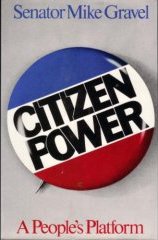
As both an elected public official and a private citizen, I have become increasingly distressed over the continuing exclusion of the people from any meaningful role in our governmental, economic, and social power structures. At the same time, I have become acutely aware of the rising dissatisfaction and crumbling patience among citizens constantly frustrated in efforts to participate in decision-making processes which directly impinge on their lives. Gravel, M. (1972) Citizen power: A people’s platform. Holt, Rinehart and Winston. ISBN 0030914655
For the Many or the Few
Posted June 7th, 2008 by jpritikin
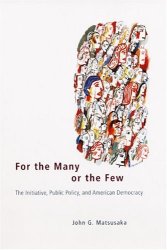
[original] Ballot initiatives, though sometimes perceived as the tool of special interests, actually reflect the wishes of the majority, says a new book by John Matsusaka, professor of finance and business economics in the USC Marshall School of Business.
“For the Many or the Few: The Initiative, Public Policy and American Democracy” (University of Chicago Press) analyzes the initiative, a process in which citizens propose new laws by gathering the signatures of peers.
To write the book, Matsusaka examined more than a century of data from 50 states and 4,700 cities – including tax and spending data, and opinion data – to gauge the majority’s preference.
In comparing the policies created by the initiative to the expressed preference of the voters, he found that in each instance, the initiative reflected the majority’s preference.
“The idea that the initiative process empowers special interests doesn’t fit with the facts,” Matsusaka said. “You can still dislike the initiative process after seeing my results, but not because you think it allows special interests to subvert the majority.”
“For the Many or the Few” also tackles the preconception that the initiative process is a recent expression of democracy, when in fact it was first incorporated into a state constitution – South Dakota’s – in 1898.
“People have the idea that this is something new,” said Matsusaka, also president of the Initiative & Referendum Institute, a nonprofit, nonpartisan think tank based at USC. “It’s been around a long time, and it’s clear the sky hasn’t fallen because of it.”
That said, Matsusaka cites “unprecedented growth” in the popularity of initiatives in the last 10 to 15 years. “People are much more educated and have access to much more information,” he said. “Therefore, people see less and less need to turn over authority on broad policy decisions. The government is left to implement them.”
Other key findings in “For the Many or the Few”:
Generally, the initiative seems to have pushed policy in a fiscally conservative direction since about 1970, reducing the spending and taxes of state and local governments. However, “there is no evidence that voters irrationally use the initiative to cut their taxes while at the same time increasing spending,” Matsusaka said.
By contrast, voters in the early 20th century used an initiative to increase spending on public schools and welfare, progressive acts in the face of legislatures dominated by conservative interests. “The initiative is best seen as a device to push policy back toward the middle of the political spectrum when the elected government strays too far in the conservative or liberal direction,” Matsusaka said.
Twenty-four states and the District of Columbia have the initiative procedure. According to the 2000 census, that represents a total population of 136 million, or roughly half the nation’s total.
About 70 percent of the U.S. population lives in either a state or city with the initiative. It’s most widespread in the West, but can be found in all regions of the country, from the Northeast (Maine, Massachusetts) to the Midwest (Michigan, Ohio) to the South (Arkansas, Florida).
Direct democracy flourishes outside the United States as well. Ten European countries allow initiatives, as do six of the post-Soviet states and the proposed constitution for the European Union. Most European countries use referendums – a measure passed on for a popular vote by a legislative body – for important public decisions; 29 elections were held on European integration alone.
Matsusaka’s book is careful to avoid any opinion on the effects of initiatives. “What’s a ‘good’ policy is a really subjective question,” Matsusaka said, adding, “Our constitution is designed to stifle majority rule if minority rights are threatened.”
In his findings, 70 to 80 percent of voters are glad to have the initiative process. “On balance, people think it’s better to have initiatives than not,” Matsusaka said. “It’s not perfect, but government never is.”
Matsusaka, J. G. (2004). For the many or the few: The initiative, public policy, and American democracy. University Of Chicago Press. ISBN 0226510816
For the People: What the Constitution Really Says About Your Rights
Posted June 2nd, 2008 by jpritikin
A strange sight, indeed: Popular sovereignty is taken seriously in a discussion of the Constitution. In this populist interpretation of the Constitution, Amar (Law/Yale) and Hirsch (a freelance writer and graduate of Yale Law School) insist that “we the people” denotes a collective entity, not a collection of individuals. They contend that viewing the Constitution “through the prism of the individual” has overemphasized the majority-rule/minority-rights debate and has been reinforced by the tendency to dissect discrete passages rather than interpret the document as a whole. We have come to assume that “rights” refers to individual rights, ignoring the politically more fundamental conception of rights held by the public as a whole. Amar and Hirsch respond to this deficiency by exploring the implications of a broad reading (not to be confused with loose construction) of the Constitution regarding constitutional amendment, juries, and the military. In this volume’s most controversial argument, the authors maintain that the specific procedures for amendment outlined in the Constitution do not preclude direct amendment by majority vote of the populace. The logic is inescapably democratic: If popular sovereignty is meaningful, how could the people be deprived of the right to amend the Constitution? Similarly, Amar and Hirsch find inalienable rights applicable to juries and the military, with straightforward implications. Peremptory challenges eliminating a candidate from jury service, for example, are not consistent with either the citizen’s right to serve or the public’s right to try the accused. Access to military service is no less a citizen’s right or a public concern, consequently the authors argue that blocking the entry of gays or women into the ranks is indefensibleif the rights of “we the people” are truly paramount. Consistent and contentious throughout, Amar and Hirsch offer an analysis that should threaten both liberals and conservatives with a commitment to popular sovereignty both like to avoid. — Copyright ©1998, Kirkus Associates, LP. All rights reserved.
Amar, A. R., Hirsch A. (1999). For the People: What the Constitution Really Says About Your Rights. Touchstone. ISBN 0684871025
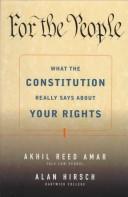
| Attachment | Size |
|---|---|
| amar_2002.pdf | 179.05 KB |
Educated by Initiative: The Effects of Direct Democracy on Citizens and Political Organizations in the American States
Posted May 31st, 2008 by jpritikin
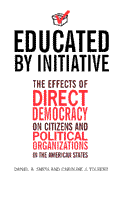
Educated by Initiative moves beyond previous evaluations of public policy to emphasize the educational importance of the initiative process itself. Since a majority of ballots ultimately fail or get overturned by the courts, Smith and Tolbert suggest that the educational consequences of initiative voting may be more important than the outcomes of the ballots themselves. The result is a fascinating and thoroughly-researched book about how direct democracy teaches citizens about politics, voting, civic engagement and the influence of special interests and political parties. Designed to be accessible to anyone interested in the future of American democracy, the book includes boxes (titled "What Matters") that succinctly summarize the authors’ data into easily readable analyses.
Smith, D. A., & Tolbert, C. J. (2004). Educated by Initiative: The Effects of Direct Democracy on Citizens and Political Organizations in the American States. University of Michigan Press.
